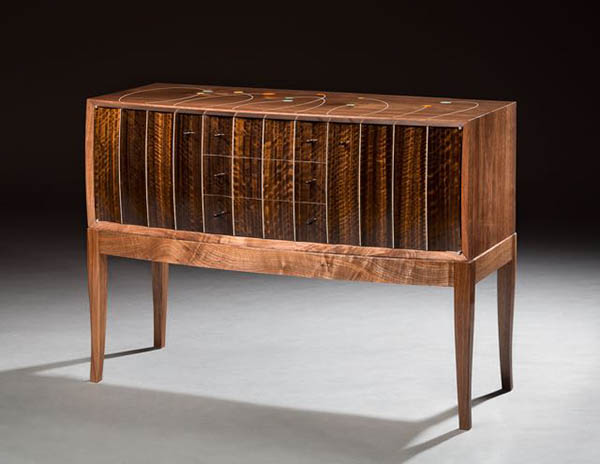
Owain Harris’s first introduction to a woodworking-related field came as he joined a framing crew in mid 1990s New England. He was motivated both by romantic notions about building a house and, as a 22-year-old bartender, by “realizing that working till 2 a.m. and then staying up till dawn shooting pool was probably not a healthy way to live your life.”
As a framer, he discovered that he really loved working with wood and making things, but the constant exposure to heat and cold brought another life choice revelation: “I quickly realized that, if I could get inside, that would be preferable.”
Eventually, through stints as a finish carpenter and a remodeler in partnership with a friend, Owain connected with an Art Nouveau style furniture maker who had a “huge commission” in Florida. The couple of years working on that project was “really where I got my first exposure to more fine furniture. It was a real crash course in improving my skills,” Owain said.
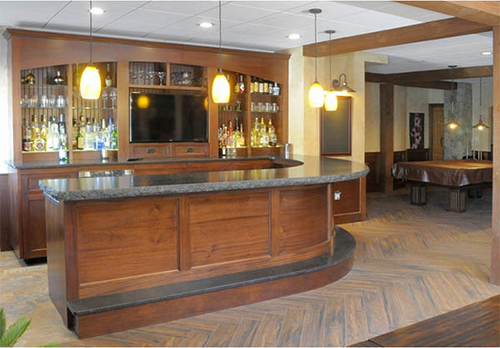
He’s been running his own shop in New Hampshire for the past eight or nine years, and has intentionally made the decision to keep it a one-man operation. “That means that I don’t tend to go after just runs of standard cabinetry. I tend to be more niche than that. At the end of the day, I am in it to make a living, and the things I can make money on tend to be the more built-in cabinetry type stuff” – but not necessarily just the prevalent “frame-and-panel stuff with a classic molding of some kind.”
For instance, he did an Airstream renovation last year and has also done a project with a “big, curved mahogany bar and a built-in wine cellar.”
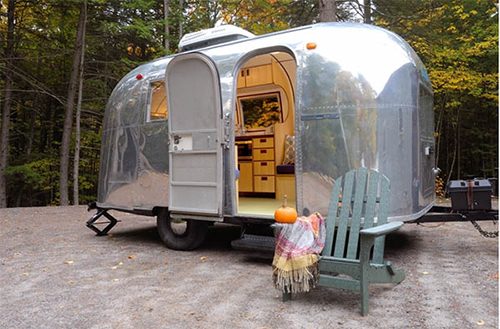
Owain also does some architectural millwork, pieces for clients that are often anniversary or birthday gifts that incorporate engraving, and freestanding pieces. “The market’s constantly changing, but being a one-man shop I feel allows me the flexibility to pursue where the market is and take opportunities as they come in. I’ve got a pretty big space, and it’s tooled up pretty well for all kinds of different projects.”
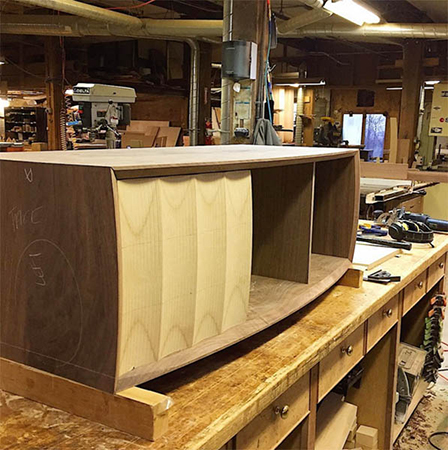
One tool he uses often is the vacuum press, as he does a lot of curved work with veneer and bent lamination. “So definitely the vacuum press, I couldn’t do what I do without.” About a year ago, he also bought a CNC router. “That’s kind of been a trip trying to figure out how to incorporate that into my process. It’s kind of a no-brainer when it comes to the cabinetry side of things, just for punching out sheet goods for cabinetry it’s brilliant” – but Owain also wants to incorporate the CNC into his furniture designs.
“I think part of being successful as a fine furniture maker in 2017 is being able to figure out what the best tool for the job is. Sometimes that’s a CNC or something very high-tech, and sometimes it’s still a tool that’s been around for hundreds of years. I sort of jokingly using the hashtag ‘21st century woodworker’ sometimes on Instagram because I love the idea that, in one part of the day, I could be writing computer code and running CNC, and then later in the day, I’m still using a lot of traditional hand tool skills.” That might include hand planes or hand inlay tools such as scratch dogs.
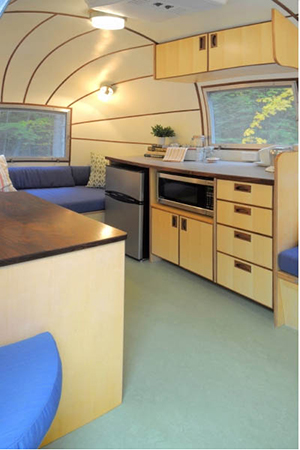
At least once a year, Owain also tries to produce a spec piece “that’s kind of pursuing my own voice as a studio maker.” In 2017, Owain has been an Invited Artist exhibiting with the New Hampshire Furniture Masters Association, “and that’s something that’s been great because it’s kind of allowed me an outlet to get that work out into the world as well,” Owain said. Plus, “One of the nice things about an organization where you have a lot of furniture makers at the top of their game, they tend to push each other, push the work even further.”
His own aesthetic for his studio furniture pieces incorporates traditional forms that Owain says can be traced back to Federal, Art Deco or Arts and Crafts style furniture, “but I try to sort of update that a little bit and make it a bit more contemporary and put my own spin on it. I try to inject a little bit of fin and a little bit of whimsy and asymmetry into all my designs so that it doesn’t get too bogged down in the formality of that traditional form. I like to describe it as being furniture that’s serious but doesn’t take itself too seriously.”
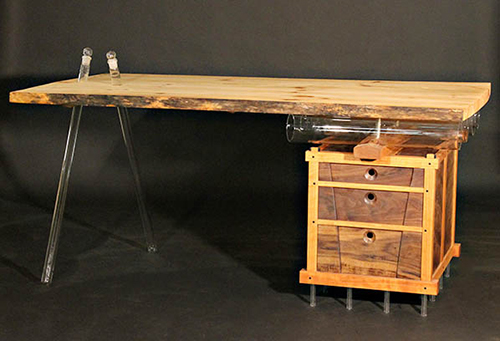
For example, his recent “Escape Velocity” sideboard is styled in the Art Deco manner, with stringing that goes up through the doors, but as the inlay continues on to the top of the piece, “The stringing goes off in all kind of crazy directions, and it terminates in an inlaid circle of dyed veneers. It’s intended to kind of look like fireworks, or a stylized sort of fireworks.”
The idea of the piece, Owain said, is that, “There’s a lot of tension being built up in the curves and the casework, and then that’s kind of getting released as the inlay goes through the top of the piece and then goes off.”
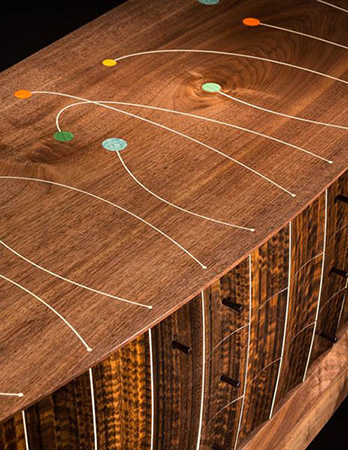
He has also made an Art Deco style console table which also features an inlay but, “rather than your typical stringing that goes around the outside of a veneered field, it goes off into a curve and terminates in this little flower inlay motif. I think that’s a good example of taking the idea of what a typical string inlay on a veneered tabletop would look like and then playing with that and subverting it a little bit.”
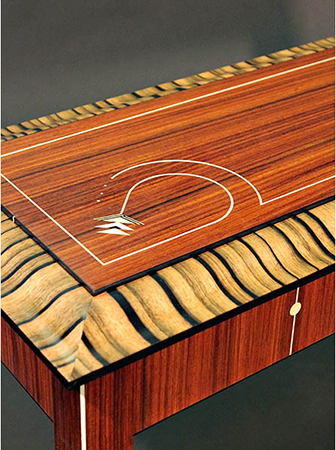
When it comes to veneer, Owain is drawn to straight grain with contrast: Douglas fir, macassar ebony, rosewood. For solid wood, he’s had a past fondness for cherry and a lot of client requests for walnut, but recently, he’s been gravitating toward hard maple. “That’s been appealing to me: a nice, white piece of maple, with a nice grain structure – you can do a lot with it. I’m an embellisher. I like to decorate my pieces, so having kind of a neutral palette is nice.”
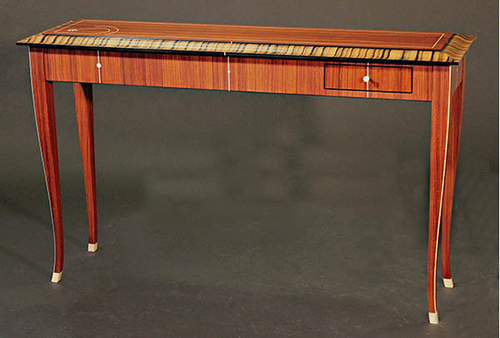
Over the next few years, Owain said, his goal is to start stockpiling and drying locally sourced woods. “I think it adds to the story of what you’re doing if you can use material from your neighborhood and be partnering with people that are harvesting it sustainably in your area. I live in the Northeast. I’m surrounded by the material that I use, and yet I’m buying it from places that are sourcing it from thousands of miles away, and that seems insane.”
His future plans also include teaching, in October, the machine woodworking portion of the nine-month furniture comprehensive program at the Center for Furniture Craftsmanship. Owain himself “never ended up doing the furniture school route,” but he finds teaching, which he’s been doing for the past couple of years, to have been an important addition to his own experience as a woodworker.
“Being able to be around students that are super-excited about getting into the craft and seeing what they’re doing, it’s been really rewarding. It gets me amped up again. Sometimes, when you’re doing this for a job, it’s like any job: it can be a grind at a certain point. But going up there and teaching for a few weeks, it’s a reminder that I’ve got the greatest job in the world, and I shouldn’t take it for granted. I always come back refreshed and ready to go again.”






